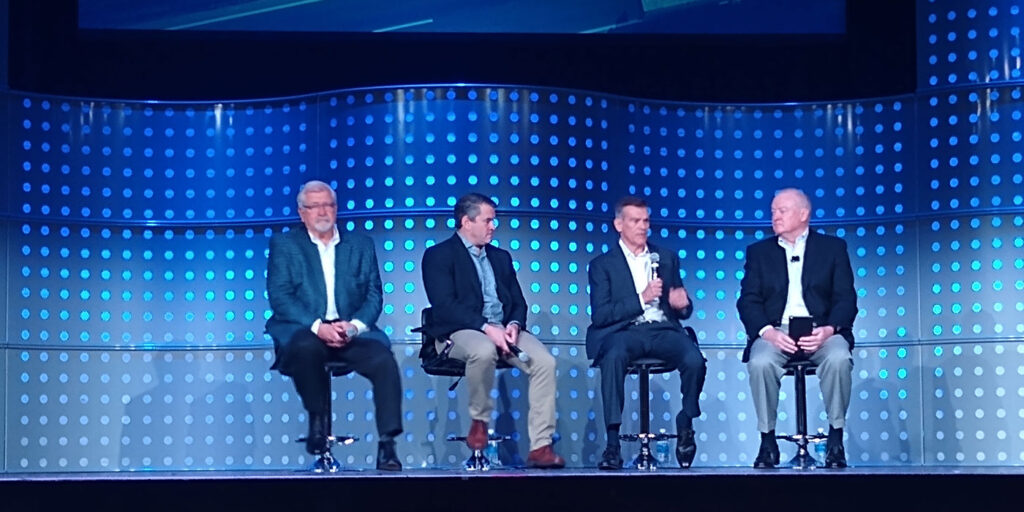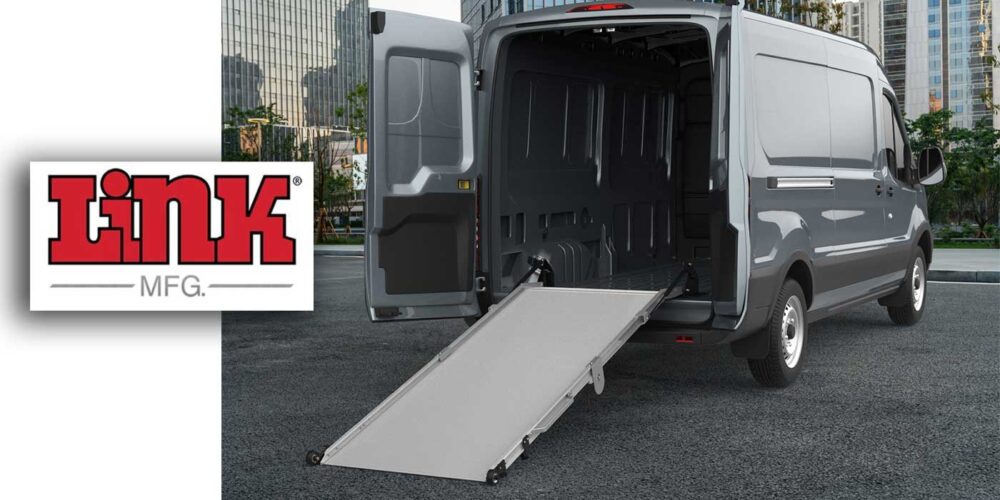We’re back at the Gaylord Texan for Heavy Duty Aftermarket Dialogue (HDAD) presented by HDMA and MacKay and Co. The last time we were together in person it was in 2020 just before the pandemic hit. Then, the big talking points were independent service aims to keep up with truck technology, training and finding technicians, and the evolving world of aftermarket parts. So come along as I chart the biggest takeaways from this year’s HDAD.
Panel one. Let’s Rap: A real-world view of the aftermarket
This is the true story of three aftermarket executives picked to be on a panel to talk about what happens when the world changes and things get real in the aftermarket.
• John Coll, senior vice president, global marketing, sales and services, Allison Transmission
• Walt Frankiewicz, president, Haldex Americas and executive vice president Haldex AB
• Mike Hawthorne, president and CEO, Bendix CVS
Moderator: Chris Patterson – Independent Director
(Panel pictured above. Right to left: Frankiewicz; Hawthorne; Coll; Patterson.)
It goes without saying, but we’ll say it anyway: A lot has changed since January 2020.
It starts with supply chain challenges but continues with other challenges
Hawthorne: It’s a struggle and there’s a reality we all face from semiconductors to raw materials prices. What we can do is understand the options of where we can make an impact. An area not getting enough airtime is labor–it’s a challenge in producing and delivering product. It’s a perfect storm of challenges. There’s no magic bullet, it just takes hard work … and overtime, it’ll work itself out.
Frankiewicz: The paramount issue has been logistics and getting parts to the right place to the right time. We’re avoiding Long Beach and we’re going through other ports. There are logistics challenges that go along with that, but we’re flexible. On Labor: We’re managing through it with flexible staffing. And the third point is that we remained stoic as long as we could in light of these advancing challenges. We want to get the parts to customers ASAP. We’ve created new channels to do that, and there’s been a cost associated with that, but we’ve stayed focused on the customer.
Coll: We’re trying to take a balanced view in the long term. We’re still looking at demand and we’re looking at the labor–that’s going to the next level with Omnicron–then the supply chain of course. But we have to remain positive. There’s resiliency in the heavy-duty market … The OEM backlog is a year out, we’ve never seen it at this point. And not a lot of “water” in there (or orders that aren’t real).
Microchip supply news might not apply to heavy-duty
Coll noted that much of the news about new chip manufacturing capabilities are microchips that are slated for new technology, whereas heavy-duty manufacturers use “legacy chips.” He was cautious that any new microchip production capabilities or supply chains would primarily help automotive manufacturers.
“There’s a bit of the mystique around microchips. These aren’t sophisticated [components]. They’re a basic transistor, but you can make them and then put them in microprocessors and sell them for much more. So that’s the issue,” Frankiewicz said.
Dealing with labor
Hawthorne noted that pay is just one component of retaining labor. “We look at our plants holistically,” he said. “You have to have amenities on site and you have to be flexible.”
Flexibility is more easily talked about than put in place on a manufacturing line. Coll explained that Allison Transmission staff, across the board, stayed in the office as essential workers. “We didn’t want two different classes of employees.
“This is, for us, the No. 1 issue we’re dealing with,” Coll noted.
Parts pricing strategies
Frankiewicz stated simply that if costs rise, “There is little opportunity for us to absorb those increases and continue to exist as a company.”
“Transparency on how you develop the costs is key. The costs are coming in not because of difficulties we’ve created, but this is just the world we live in. Our customers are understanding that,” Hawthorne said. “But you have how you’ve built your business on the backend and to be transparent you have to disclose more than you have in the past. In the next year or more we’re going to figure out how to be more transparent with our customers.”
“It’s about knowing that we’re all in this together and it transcends the commercial vehicle industry, and I see people being more patient–they’re having a conversation, trying to understand, and working together,” Coll said.
Frankiewicz brought it back to relationships–the defining feature of the heavy-duty commercial market.
Panel two. Government affairs: Implications on the aftermarket
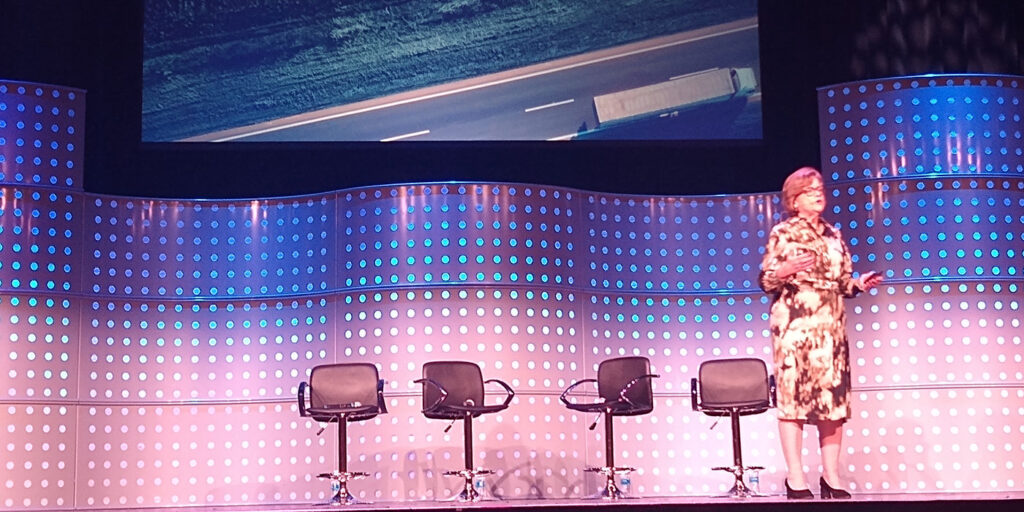
On the stage:
• Ann Wilson, senior vice president, government affairs, MEMA
Moderator: Bill Long, president and CEO, MEMA
Wilson sets out to answer the question: How does D.C. impact your heavy-duty aftermarket business?
“In the aftermarket, there’s a feeling that, ‘D.C. doesn’t affect us.’ Times have changed,” Wilson said. “There are things going on right now that impact the aftermarket first and primarily. There are challenges that Washington is trying to address now that will impact your aftermarket business day-to-day.”
HDMA members and the heavy-duty industry is the most regulated segment of our industry. OEMs are regulated, fleets are regulated, the drivers are regulated.
Presidential Executive Orders have swirled around 18-year-old truck driver actions to help ease the supply chain labor shortage, as well as parts data and service opportunities for the aftermarket. But those are still works in progress. The mixed bag is the environmental issues on fuel efficiency-focused on moving toward electrification and lower emissions trucks, Wilson said. (More on that in a minute.)
Vaccine mandate for truck drivers
The Supreme Court decided that OSHA did not have the power [to enforce the mandate]. Wilson noted that the issue, currently, cannot be revisited, and if the administration wanted to push the mandate forward they’d “have to do it in a different way, and those options are very, very limited,” Wilson noted.
Infrastructure bill impact
“The president has made climate one of the premier issues of his administration,” Wilson said.
There are manufacturing incentive tax credit 48C: Manufacturers can go to the department of energy, show what they’re manufacturing that meets the criteria and receive a tax credit. There is also a program for retooling and one for conversion in terms of supply chain partners, if they pace. Purchasing incentives are also available, but Wilson noted that these incentives are difficult and still undefined.
Electric vehicles: How this idea moves forward
“Make no mistake: This administration is absolutely committed to doing this,” Wilson said. “Whether it’s viable, whether we have the charging for it, the customer demand for it–all that is being debated on a daily basis.
“This is the last opportunity to make an impact on the heavy-duty NOx standards. Some say it’s setting us up for another 2007 pre-buy situation. We expect a proposal on this the first quarter of this year.
“The president has directed the EPA to move forward on a heavy-duty standard for electric vehicles,” Wilson continued. “The administration does not see this as a single set of vehicles. They’ve invested in electrifying school buses, in electrifying straight trucks. They’re finding a path forward for ‘zero-emissions’ vehicles.”
New safety mandates on the way
Wilson ticked off the new mandates:
- Heavy vehicle automatic emergency braking;
- Rear underride protection in heavy trucks;
- Side underride protection in heavy trucks;
- Connected vehicle technology that directs the DOT to research things such as platooning and vehicle-to-vehicle communications; and
- Crash causation study.
Panel three. The global economic overview
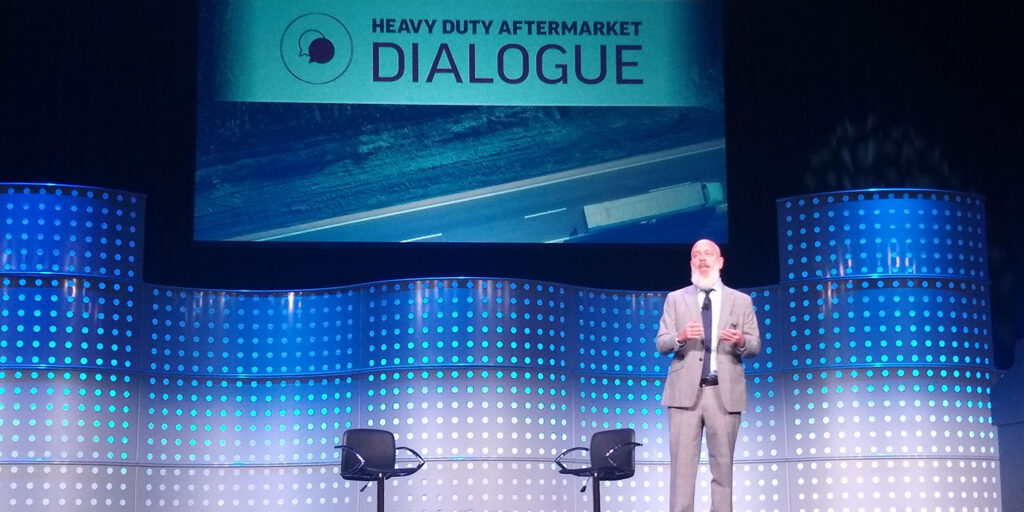
On stage:
• Kevin Depew, deputy chief economist, RSM
Moderator: Dr. Bob Dieli, economist, MacKay and Co.
Depew ran through a rapid-fire bullet point list on what the post-pandemic economy may look like as COVID evolves into an epidemic.
“Labor wasn’t an issue the pandemic created, but it made the situation worse,” Depew said, echoing the labor challenges that all of the panelists have noted thus far.
Depew noted that unemployment should fall to 3.4% by the end of 2022. There is $2.7 trillion in excess savings vs. pre-pandemic. Fourth-quarter 2021 GDP was at 6.2%. The housing boom will continue with residential starts to bolster growth.
“This is an economy that is fundamentally more sound than we’ve seen since the ’80s and mid-’90s,” Depew said. “There’s robust sentiment. Hiring plans, cap ex plans, growth plans, all continue to be positive … but the tight labor market is going to persist.”
Today’s tight labor market is driven by demographics, according to Depew. “The millennials are already here and the generation after them is more similar to Gen X,” he said, noting that Baby Boomer retirements continue to accelerate.
A big takeaway: “We’re all still engaging in robust economic activity, but it doesn’t feel great,” Depew.
Panel four. Aftermarket industry economy and outlook
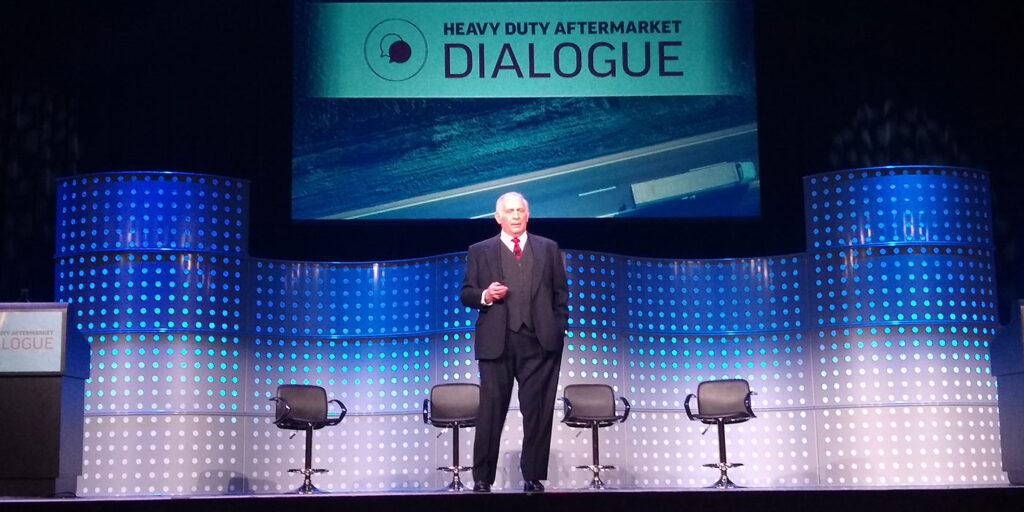
On deck:
• Dr. Bob Dieli, economist, MacKay and Co.
Dieli noted that the supply chain issues that have made up a bulk of the talking points this morning existed before the pandemic. The pandemic just brought them to the forefront.
“We’re getting readings from the [economic] model that we might have some unpleasantness ahead of us,” Dieli said. “It’s best to take a cautious approach in the years ahead.”
Black swans in the market
To monitor the health of the market, Dieli noted that he tracks: Inflation; housing starts; freight rates; and trucking employment.
“Inflation is to the economy what your tachometer is to your engine,” he said. “If it’s too high you blow the engine. If it’s too low, you stall the engine.
“Prices are signals,” he continued. “How, why and when they change are every bit as important as how much they change.”
Who’s creating the inflation?
A fun chart that Dieli said that he only gets to use every four or eight years answers the question: Which political party creates inflation?
The answer: Both.
The average increase of inflation during Republican presidents is 5.93%; Democratic president is 5.92%, according to Dieli’s chart.
Panel five. Glimpsing the aftermarket’s future: Imminent commercial vehicle technologies
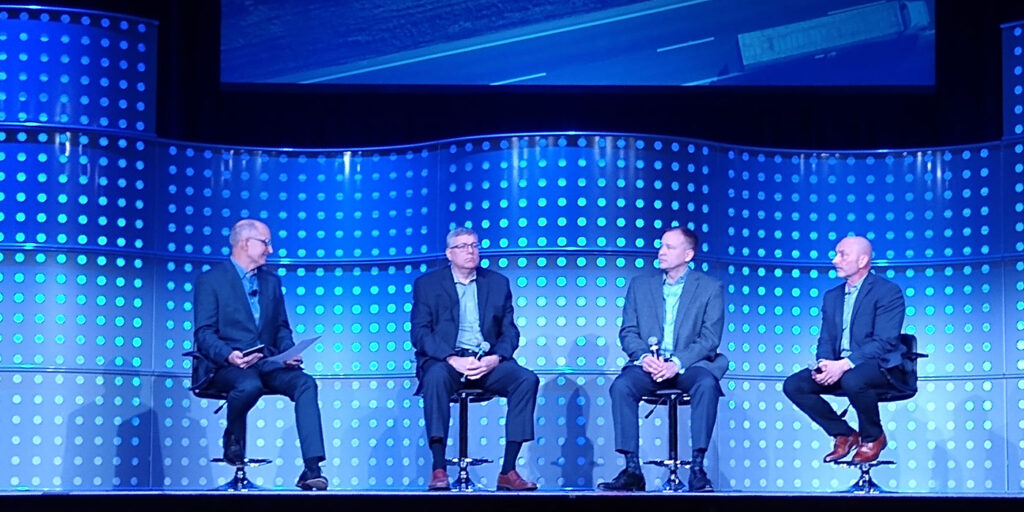
In the hot seats:
• Bill Black, president and CEO, national fleet management and heavy-duty truck supply
• John Nelligan, senior vice president and president, truck, Americas, Meritor Inc.
• Mike Eppes, managing vice president of operations, Rush Enterprises
Moderator: Roger Nielsen, mobility investor and advisor
How is the aftermarket ready to service new truck technology?
Eppes: The biggest thing we’ve seen across platforms is that every truck manufacturer has its own telematics. There aren’t that many fleets that are a single brand. The small fleets take [telematics] tools off the shelf; many of the large fleets are creating their own telematics solutions. Everyone is doing different things. The challenge, in the end, is what they’re trying to get to–the data that’s inside. What are the trigger points for when they should bring a truck in for service across all of the brands they run?
Black: When telematics came out they had a lot of benefits and what I’ve found is getting the customers to use the data and then share it with us has been very difficult. They’re using it more for GPS and location, we’ve struggled to partner with our customers to get that data and use it to keep vehicles on the road.
Preparing the aftermarket for electrification
Nelligan: We need to be able to have upfitters put an electric axle on the current architecture of a truck. The next thing we thought about was training. It’s a steep ramp up for training. During the pandemic, we doubled down during virtual training, mostly because we had to, but we’ve seen really great results from it. We think this will be key. Training, training, training.
End of battery life
Eppes: On the training side–the removal and handling–we get great training from our partners and that’s key. The core of this is that there’s a good process in the industry. I think these batteries have the rare Earth metals, there are going to be other materials that people will want to reclaim.
Where are the opportunities for the independent aftermarket in electrification?
Black: We feel like the opportunities are in the information. In our industry, we’ve operated on a [backlog]. What slows us down is lack of data and lack of information. We’re trying to find partners. There’s plenty for everyone to go around.
Eppes: We’re all trying to figure the repair and replacement cycle out. We don’t think it’s going to change overnight. What we’re looking at is behavior of the customer and their expectations for service. They bring vehicles to the shop, we fix them in the bay, but talk about Tesla–the technician comes to the car. Is that going to come into our space? Is it going to change expectations on where the vehicle is repaired?
Navigating change and customers adopting technologies
Nelligan: If you’re a fleet, you see this coming. A lot of people would rather try some on their own terms with one, five or 10 trucks, than when it comes time to buy 500. Everyone wants to know what your “green” plan is. It’s driving a lot of private fleets because they have an image out there. They’re going zero emissions to have greener trucks. Then there’s a place like the Port of LA, they all have to be electric or natural gas by 2025. People want to try these trucks on their own terms.

